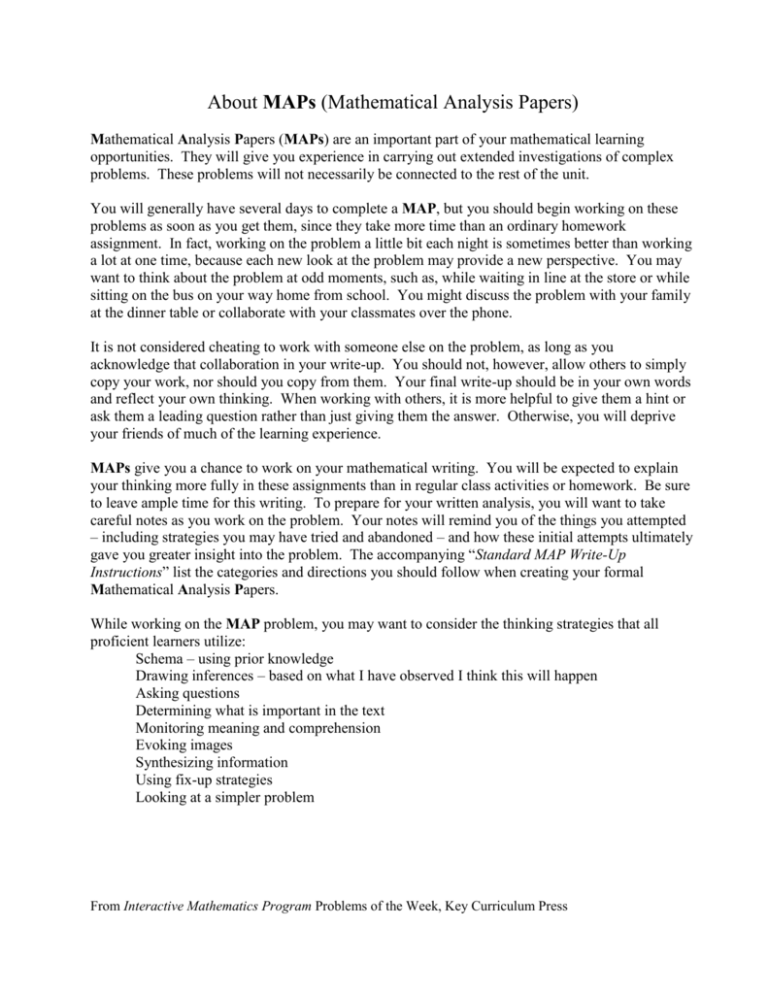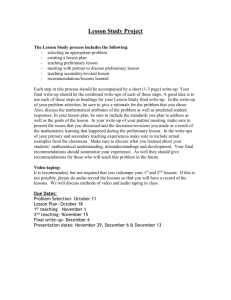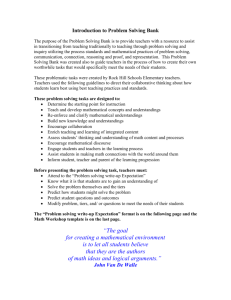About MAPs (Mathematical Analysis Papers)
advertisement

About MAPs (Mathematical Analysis Papers) Mathematical Analysis Papers (MAPs) are an important part of your mathematical learning opportunities. They will give you experience in carrying out extended investigations of complex problems. These problems will not necessarily be connected to the rest of the unit. You will generally have several days to complete a MAP, but you should begin working on these problems as soon as you get them, since they take more time than an ordinary homework assignment. In fact, working on the problem a little bit each night is sometimes better than working a lot at one time, because each new look at the problem may provide a new perspective. You may want to think about the problem at odd moments, such as, while waiting in line at the store or while sitting on the bus on your way home from school. You might discuss the problem with your family at the dinner table or collaborate with your classmates over the phone. It is not considered cheating to work with someone else on the problem, as long as you acknowledge that collaboration in your write-up. You should not, however, allow others to simply copy your work, nor should you copy from them. Your final write-up should be in your own words and reflect your own thinking. When working with others, it is more helpful to give them a hint or ask them a leading question rather than just giving them the answer. Otherwise, you will deprive your friends of much of the learning experience. MAPs give you a chance to work on your mathematical writing. You will be expected to explain your thinking more fully in these assignments than in regular class activities or homework. Be sure to leave ample time for this writing. To prepare for your written analysis, you will want to take careful notes as you work on the problem. Your notes will remind you of the things you attempted – including strategies you may have tried and abandoned – and how these initial attempts ultimately gave you greater insight into the problem. The accompanying “Standard MAP Write-Up Instructions” list the categories and directions you should follow when creating your formal Mathematical Analysis Papers. While working on the MAP problem, you may want to consider the thinking strategies that all proficient learners utilize: Schema – using prior knowledge Drawing inferences – based on what I have observed I think this will happen Asking questions Determining what is important in the text Monitoring meaning and comprehension Evoking images Synthesizing information Using fix-up strategies Looking at a simpler problem From Interactive Mathematics Program Problems of the Week, Key Curriculum Press Standard MAP (Mathematical Analysis Paper) Write-Up Instructions Mathematical Analysis Papers give you a chance to work on your mathematical writing. You will be expected to carefully explain your thinking about a significant problem. The following instructions list the categories and directions you should follow when creating your formal MAP write-ups. 1. PROBLEM STATEMENT State the problem clearly in your own words. Your problem statement should be clear enough that someone unfamiliar with the problem could understand what it is that you are being asked to do. 2. PROCESS Describe what you did in attempting to solve the problem, using your notes as a reminder. Include things that didn’t work out or that seemed like a waste of time. Do this part of the write-up even if you didn’t solve the problem. If you get assistance of any kind on the problem, you should indicate what the assistance was and how it helped you. 3. SOLUTION State your solution as clearly as you can. Explain how you know that your solution is correct and complete. If you obtained only a partial solution, give that. If you were able to generalize the problem, include your results. Your explanation should be written in a way that will be convincing to someone else – even someone who initially disagrees with your answer. 4. EVALUATION Discuss your personal reaction to the problem. For example, you might respond to the following questions: What did you find difficult about the problem? What was easy about the problem? What did you learn from doing the problem? Can you invent some extensions or variations to the problem? That is, what other kinds of problems are related to this one? How have you grown as a mathematician by doing this problem? 5. SELF-ASSESSMENT Based on your effort and your results on this problem, what grade do you think you deserve and why? What evidence have you included to support this self-assessment? From Interactive Mathematics Program Problems of the Week, Key Curriculum Press








